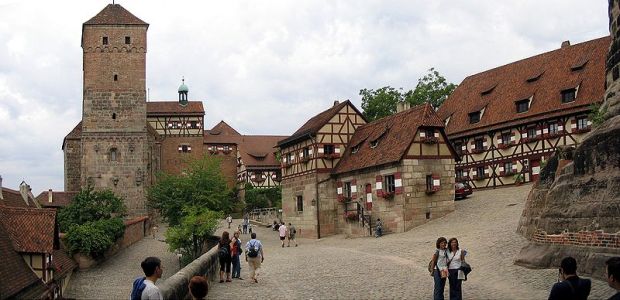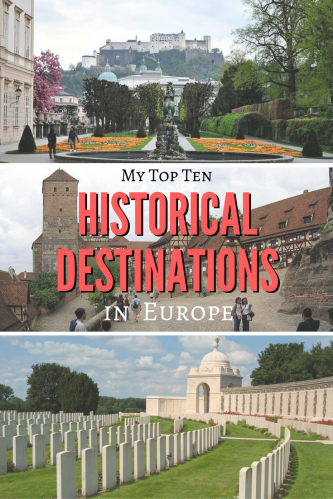There are countless historical destinations in Europe to choose between when planning your travels. Anyone who lives here is gifted with easy access to thousands of museums, castles, palaces, fortresses and monuments covering millennia of European history. Anyone outside of Europe usually makes a point to visit at least a few of these (in between, understandably, scoffing Italian pizza and partaking in Oktoberfest).
It’s difficult to know where to start if you want to see the best of the bunch, so I’ve compiled my personal top ten historical destinations in Europe. I have visited every location on the list below and can personally vouch for both the quality and quantity of historical sights. More than half are also UNESCO World Heritage sites to boot.
10. Budapest, Hungary
Great for architecture (+ UNESCO site)

St. Stephen’s Basilica
Budapest began life as two towns, Buda and Pest, that merged into today’s Hungarian capital city. Perfectly positioned on the Danube the city is littered with gorgeous old architecture – Buda Castle, the Gellert hotel, Chain Bridge, Hungarian Parliament and the Citadel. St. Stephen’s Basilica and Dohany Street Synagogue are great sights for religious history, while the Budapest History Museum traces the city’s history from Roman times.
9. Salzburg, Austria
Great for music history (+ UNESCO site)

Salzburg Fortress (© Ignaz Wiradi)
Salzburg was the home of Wolfgang Mozart, the musical prodigy and famed composer. If you’re a music history fan, this is a must. Explore the baroque architecture, visit Mozart’s birthplace and residence, go on a Sound of Music filming locations tour and keep an ear out for touring orchestras (I visited in 2007 on a school orchestra tour). The historic centre has been declared a UNESCO World Heritage site and the surrounding Alps make it incredibly picturesque.
8. Nuremberg, Germany
Great for variety

Nuremberg Castle & surrounds (© AlterVista)
The post-WWII Nuremberg Trials may be what comes to mind when you first hear the name, but there’s even more to its history than that. It used to be the unofficial capital of the Holy Roman Empire, home to German royalty and location of massive Nazi party rallies. You can visit the courthouses and Nazi rally grounds infamous from 70 years ago, but also don’t miss out on the grand Palace of Justice, Frauenkirche and St. Sabaldus Church. Visit in winter for the Christmas market and, if you’re lucky, some snow to set the scene.
7. Wales
Great for castle enthusiasts (+ UNESCO site)

Kidwelly Castle
I’m cheating a little on this one in not being more specific, but with 600 castles to choose between you can station yourself anywhere in Wales, aka the castle capital of the world. Hire a car for a weekend to explore the many castles in various states of repair, from ruins to grand fortresses. Kidwelly Castle, Caernafon Castle and Cardiff Castle are all excellent options – check out the Visit Wales website for more.
6. Venice, Italy
Great for something unique

Gondolas
Venice was settled in 400AD from the Italian mainland, and is well-known for its (sinking) network of bridges and canals. The famous gondolas have been transporting people around the Venetian lagoon since at least 1094, possibly even as early as 697. Doges’ Palace and the Basilica de San Marco are must-sees for a glimpse into the city’s past, and there are tens of art museums to explore in between the beautiful buildings.
5. WWI Battlefields, France & Belgium
Great for military history

Tyne Cot Cemetery (© Gary Blakely)
Scattered around the Belgian-French borders are WWI memorials and remnants of battlefields. I visited on a school trip about 13 years ago, but I can still remember walking through preserved trenches and finding my great-great uncle’s name on a memorial. Almost everyone in the UK has a relative who died in the war so it’s an excellent choice for some genealogy research. Ypres, Vimy and Somme are some of the most famous locations.
4. Berlin, Germany
Great for modern history (+3 UNESCO sites)

Brandenburg Gate
Over the past 350 years Berlin has been capital of Prussia, the German Empire, East Germany, West Germany and of course the current united Germany. It has survived multiple wars, Nazism and the Soviet blockade. Needless to say, the city is littered with history. Hitler’s bunker is buried under a car park, remnants of the Berlin Wall are visible everywhere and the Brandenburg Gate is still pockmarked from bullets.
3. London, England
Great for museums (+ 3 UNESCO sites)

Imperial War Museum (© IxK85)
Dinasaur skeletons in the Natural History Museum. Halls of silver and gold in the V&A Museum. The Holocaust exhibition at the Imperial War Museum. The first computers at the Science Museum… I could go on. The majority of London’s major museums are free and they are some of the best in the world. When you need a break from all of that, there’s the Tower of London and Hampton Court for royal history.
2. Naples, Italy
Great for ancient history

Temple of Jupiter, Pompeii
Base yourself in Naples for easy access to some of the best Roman sites available. Pompeii is internationally renowned, but you can also visit the equally fascinating Herculaneum and climb up Vesuvius for views over the parts of Italy destroyed 2000 years ago. The preservation at these sites is remarkable. Wooden beams first built into a house two millennia ago are still present, while some of the mosaics are brilliantly colourful. Nearby are plenty of other local museums stuffed with archaeological finds.
1. Auschwitz, Poland
Most significant (+ UNESCO site)

It’s not going to be an enjoyable visit, but it’s a necessary one. Auschwitz-Birkenau was the site of more than a million deaths of Jews, Poles, Roma & Sinti, gay men and political prisoners at the hands of the Nazis. There are two camps available to visit, Auschwitz I & Auschwitz II. You can get a guided tour around the remaining buildings with knowledgable staff who will answer any questions. There’s also an incorporated museum with thousands of confiscated glasses, shoes and prosthetics. It’s the most important historical site in Europe and works relentlessly to spread knowledge, so that nothing like the Holocaust will ever happen again.
Of course there are many more historical destinations in Europe than just the ten above. The continent is stuffed full of ancient monuments, museums, palaces, UNESCO sites and more. This list should give you a starting point for some of the very best.

Pin for later!
What are your favourite historical destinations in Europe? Tell me in the comments below!
Great list of historical site. There are so many in Europe, but this is a nice selection to start (otherwise your list will be countless 🙂 ). I’ve been to most of them, still have to visit Wales and Auschwitz.
LikeLike
Haha yes it was difficult cutting it down to 10. Maybe I’ll expand to a top 50 sometime… might take a while though 😉
LikeLike
Such great insight into these places! I’m heading to Venice soon, I had no idea it dated back to 400AD. Love that I have this bit of knowledge now!
LikeLike
Love your list! I am a european and I’ve been to many of the spots on your list but unfortunately not all of them..
LikeLike
Whaaat! So happy Wales made your list aha! I adore Wales, but I really need to get back there as I’ve only been once!
LikeLike
I live about half an hour from the border, I love heading over there to see the castles 😀 There’s so many to see! What did you see when you were there?
LikeLike
Great idea. Reminds me to consider these qualities for when I hopefully get to visit Europe. Best wishes for the site.
LikeLike
Thank you for your information. I’ve been to Europe before. I’ve vistited Spain and Germany, Netherlands, Belgium , France, England, and Italy and North Europe and so on. But there are more to visit in Europe. I knew after I read your blog. I’ll keep in mind your list to visit Europe again.
LikeLike
You’ve visited lots! But yes there’s always more to see – I’ve lived here all my life and still have a long list of places to go!
LikeLike
I have been to six of these! Not bad! I really love history. I think that is why I ma so inclined to visit Europe. I went to Auschwitz last year. It is a place that made me think a lot about me as a person and about society in general.
LikeLike